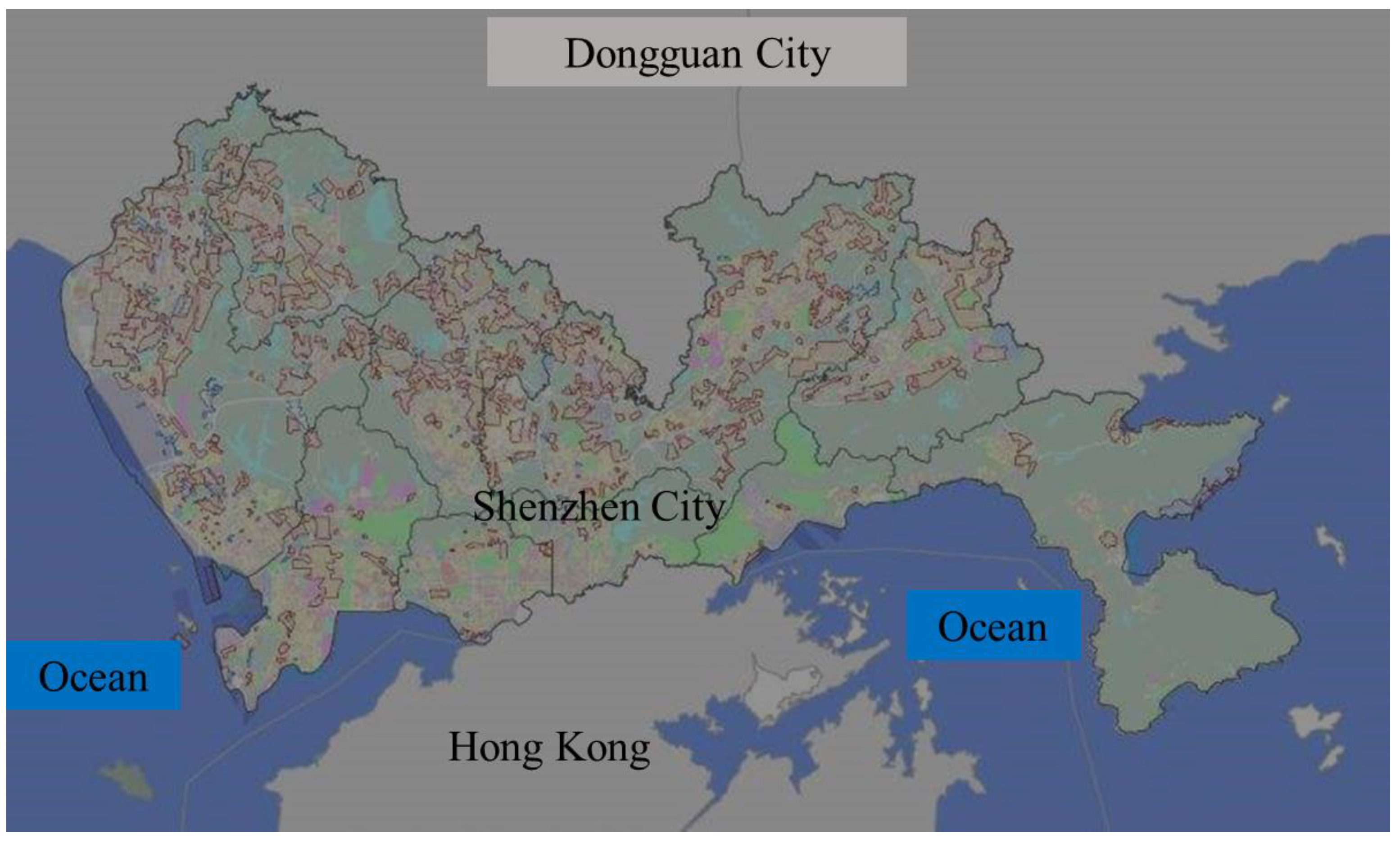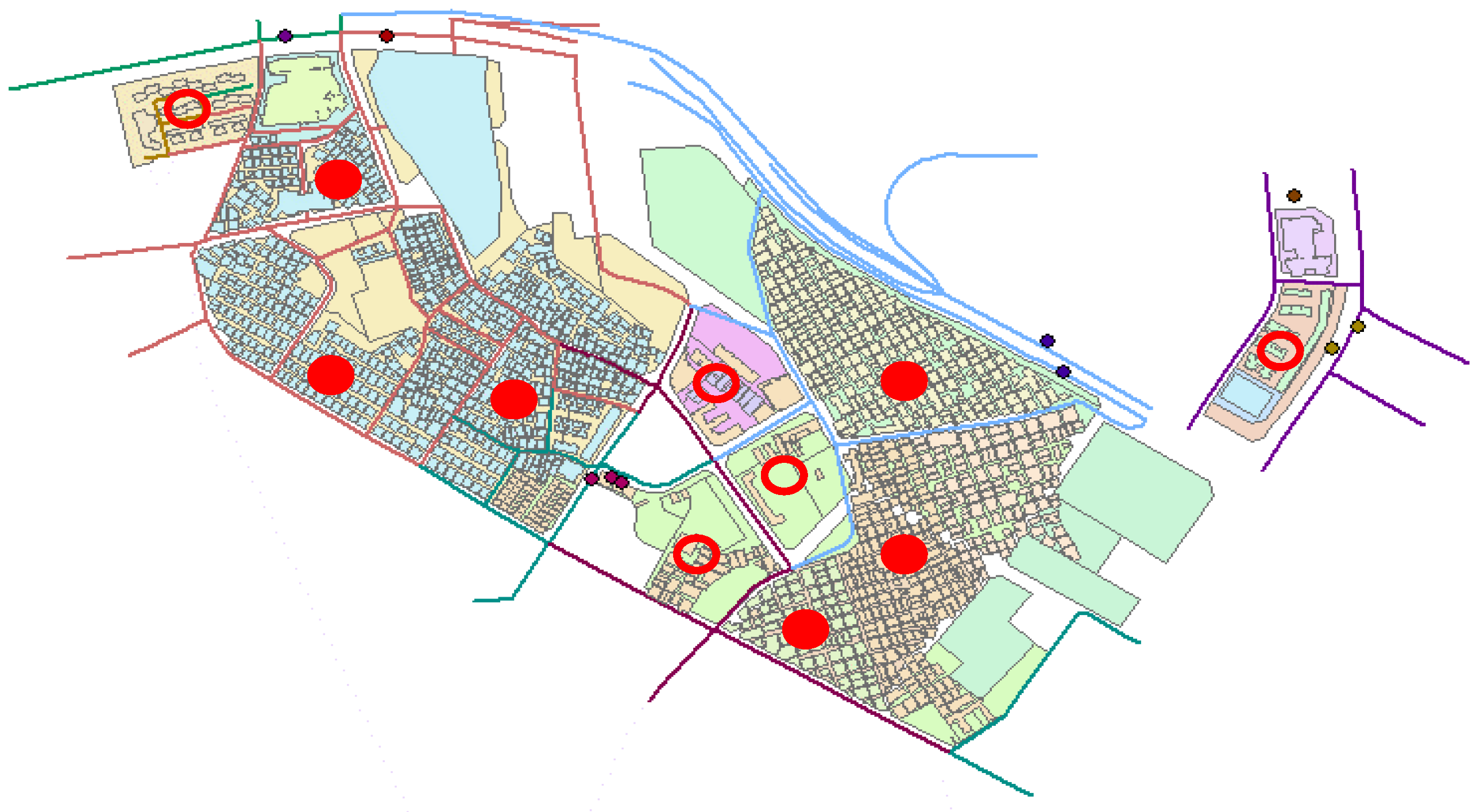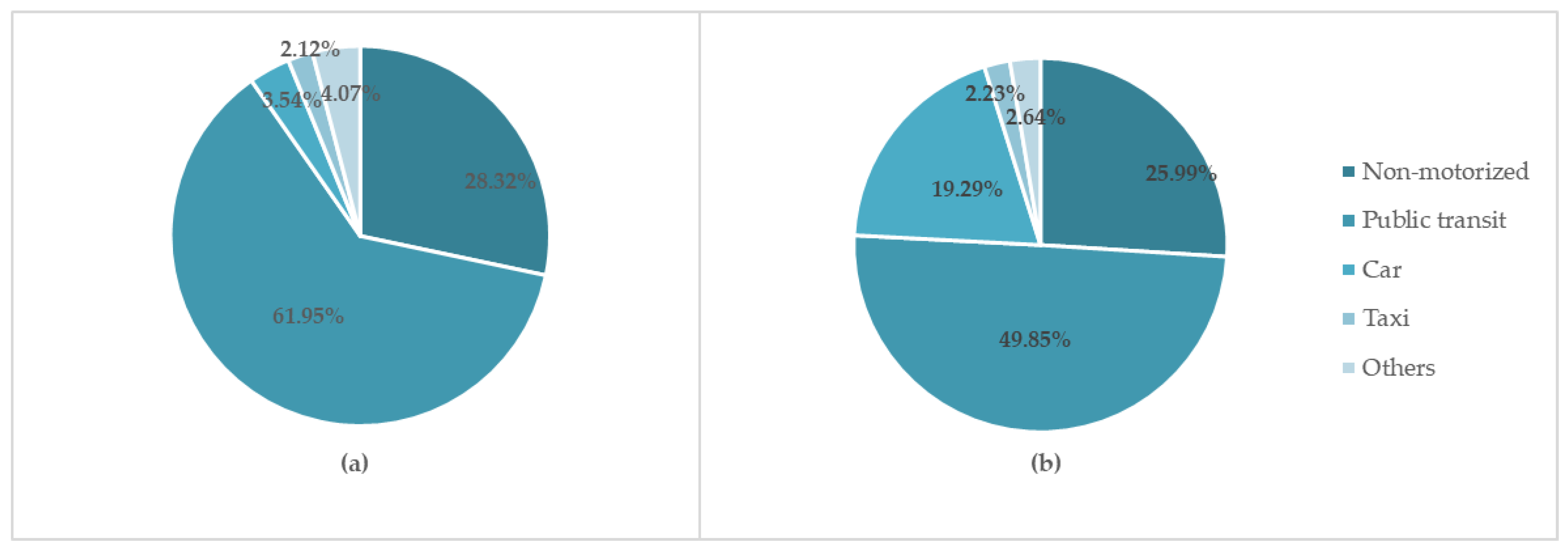How does the Built Environment Influence Public Transit Choice in Urban Villages in China?
Abstract
:1. Introduction
2. Review of Factors Influencing Choice of Mode of Travel and Behaviour by Urban Travellers
3. Materials and Methods
3.1. Data Source and Study Area
3.2. Travel Choice Behaviour Characteristics
3.3. Model and Variables Specification
4. Results
5. Discussion and Conclusions
Author Contributions
Funding
Acknowledgments
Conflicts of Interest
References
- Abenoza, R.F.; Cats, O.; Susilo, Y.O. Travel satisfaction with public transport: Determinants, user classes, regional disparities and their evolution. Transp. Res. A 2017, 95, 64–84. [Google Scholar] [CrossRef]
- Zailani, S.; Iranmanesh, M.; Masron, T.A.; Chan, T.-H. Is the intention to use public transport for different travel purposes determined by different factors? Transp. Res. D 2016, 49, 18–24. [Google Scholar] [CrossRef]
- Zhu, Y.; Wang, Y.; Ding, C. Investigating the influential factors in the metro choice behavior: Evidences from Beijing, China. KSCE J. Civ. Eng. 2016, 20, 2947–2954. [Google Scholar] [CrossRef]
- Haywood, L.; Koning, M.; Monchambert, G. Crowding in public transport: Who cares and why? Transp. Res. A 2017, 100, 215–227. [Google Scholar] [CrossRef] [Green Version]
- Chen, C.; Varley, D.; Chen, J. What Affects Transit Ridership? A Dynamic Analysis involving Multiple Factors, Lags and Asymmetric Behaviour. Urban Stud. 2010, 48, 1893–1908. [Google Scholar] [CrossRef]
- Serulle, N.U.; Cirillo, C. Transportation needs of low income population: A policy analysis for the Washington D.C. metropolitan region. J. Public Transp. 2016, 8, 103–123. [Google Scholar] [CrossRef]
- Zhang, L.; Ye, Y.; Chen, J. Urbanization, informality and housing inequality in indigenous villages: A case study of Guangzhou. Land Use Pol. 2016, 58, 32–42. [Google Scholar] [CrossRef]
- Ewing, R.; Cervero, R. Travel and the Built Environment. J. Am. Plann. Assoc. 2010, 76, 265–294. [Google Scholar] [CrossRef]
- Cervero, R. Transit-Oriented Development’s Ridership Bonus: A Product of Self-Selection and Public Policies. Environ. Plan. A 2007, 39, 2068–2085. [Google Scholar] [CrossRef]
- Soria-Lara, J.A.; Aguilera-Benavente, F.; Arranz-López, A. Integrating land use and transport practice through spatial metrics. Transp. Res. A 2016, 91, 330–345. [Google Scholar] [CrossRef]
- Feng, J.; Dijst, M.; Wissink, B.; Prillwitz, J. The impacts of household structure on the travel behaviour of seniors and young parents in China. J. Transp. Geogr. 2013, 30, 117–126. [Google Scholar] [CrossRef]
- Feng, J. The influence of built environment on travel behavior of the elderly in urban China. Transp. Res. D 2017, 52, 619–633. [Google Scholar] [CrossRef]
- Khan, S.; Maoh, H.; Lee, C.; Anderson, W. Toward sustainable urban mobility: Investigating nonwork travel behavior in a sprawled Canadian city. Int. J. Sustain. Transp. 2014, 10, 321–331. [Google Scholar] [CrossRef]
- Ding, C.; Wang, D.; Liu, C.; Zhang, Y.; Yang, J. Exploring the influence of built environment on travel mode choice considering the mediating effects of car ownership and travel distance. Transp. Res. A 2017, 100, 65–80. [Google Scholar] [CrossRef]
- Su, F.; Schmöcker, J.-D.; Bell, M.G.H. Mode Choice of Older People Before and After Shopping: A Study with London Data. J. Transp. Land Use 2009, 2, 29–46. [Google Scholar] [CrossRef]
- Sun, B.; Ermagun, A.; Dan, B. Built environmental impacts on commuting mode choice and distance: Evidence from Shanghai. Transp. Res. D 2017, 52, 441–453. [Google Scholar] [CrossRef]
- Schwanen, T.; Mokhtarian, P.L. What if you live in the wrong neighborhood? The impact of residential neighborhood type dissonance on distance traveled. Transp. Res. D 2005, 10, 127–151. [Google Scholar] [CrossRef] [Green Version]
- Wang, D.; Lin, T. Built environments, social environments, and activity-travel behavior: A case study of Hong Kong. J. Transp. Geogr. 2013, 31, 286–295. [Google Scholar] [CrossRef]
- Ureta, S. To Move or Not to Move? Social Exclusion, Accessibility and Daily Mobility among the Low-income Population in Santiago, Chile. Mobilities 2008, 3, 269–289. [Google Scholar] [CrossRef]
- Zhang, L.; Nasri, A.; Hong, J.H.; Shen, Q. How built environment affects travel behavior: A comparative analysis of the connections between land use and vehicle miles traveled in US cities. J. Transp. Land Use 2012, 5. [Google Scholar] [CrossRef] [Green Version]
- Jenelius, E.; Mattsson, L.-G.; Levinson, D. Traveler delay costs and value of time with trip chains, flexible activity scheduling and information. Transp. Res. B 2011, 45, 789–807. [Google Scholar] [CrossRef]
- Jenelius, E. The value of travel time variability with trip chains, flexible scheduling and correlated travel times. Transp. Res. B 2012, 46, 762–780. [Google Scholar] [CrossRef]
- Lucas, K.; Bates, J.; Moore, J.; Carrasco, J.A. Modelling the relationship between travel behaviours and social disadvantage. Transp. Res. A 2016, 85, 157–173. [Google Scholar] [CrossRef] [Green Version]
- Páez, A. Exploring contextual variations in land use and transport analysis using a probit model with geographical weights. J. Transp. Geogr. 2006, 14, 167–176. [Google Scholar] [CrossRef]
- Lucas, K. Making the connections between transport disadvantage and the social exclusion of low income populations in the Tshwane Region of South Africa. J. Transp. Geogr. 2011, 19, 1320–1334. [Google Scholar] [CrossRef]
- Barton, M.S.; Gibbons, J. A stop too far: How does public transportation concentration influence neighbourhood median household income? Urban Stud. 2016, 54, 538–554. [Google Scholar] [CrossRef]
- Yung, E.H.K.; Chan, E.H.W.; Xu, Y. Sustainable development and the rehabilitation of a historic urban district—Social sustainability in the case of Tianzifang in Shanghai. Sustain. Dev. 2014, 22, 95–112. [Google Scholar] [CrossRef]
- Munshi, T. Built environment and mode choice relationship for commute travel in the city of Rajkot, India. Transp. Res. D 2016, 44, 239–253. [Google Scholar] [CrossRef]
- Luo, J. Evaluating the relationship between transport service supply and urban fringe development. In Proceedings of the ICSSSM ’05. 2005 International Conference on Services Systems and Services Management, Chongqing, China, 13–15 June 2005; IEEE: Beijing, China, 2005; Volume 2, pp. 1451–1456. [Google Scholar]
- Wang, D.; Cao, X. Impacts of the built environment on activity-travel behavior: Are there differences between public and private housing residents in Hong Kong? Transp. Res. A 2017, 103, 25–35. [Google Scholar] [CrossRef]
- Manaugh, K.; El-Geneidy, A. The importance of neighborhood type dissonance in understanding the effect of the built environment on travel behavior. J. Transp. Land Use 2015, 8. [Google Scholar] [CrossRef] [Green Version]
- Cao, X. Heterogeneous effects of neighborhood type on commute mode choice: An exploration of residential dissonance in the Twin Cities. J. Transp. Geogr. 2015, 48, 188–196. [Google Scholar] [CrossRef]
- Cao, X. Disentangling the influence of neighborhood type and self-selection on driving behavior: An application of sample selection model. Transportation 2009, 36, 207–222. [Google Scholar] [CrossRef]
- Tran, M.T.; Zhang, J.; Chikaraishi, M.; Fujiwara, A. A joint analysis of residential location, work location and commuting mode choices in Hanoi, Vietnam. J. Transp. Geogr. 2016, 54, 181–193. [Google Scholar] [CrossRef]
- Bureau, S. Shenzhen Statistic Yearbook; China Statistics Press: Beijing, China, 2017. [Google Scholar]
- Abdul Hamid, H.; Bee Wah, Y.; Xie, X.-J.; Seng Huat, O. Investigating the power of goodness-of-fit tests for multinomial logistic regression. Commun. Stat.-Simul. Comput. 2017, 47, 1039–1055. [Google Scholar] [CrossRef]
- Cao, X.; Fan, Y. Exploring the Influences of Density on Travel Behavior Using Propensity Score Matching. Environ. Plan. B 2012, 39, 459–470. [Google Scholar] [CrossRef]
- Bhat, C.R.; Astroza, S.; Sidharthan, R.; Alam, M.J.B.; Khushefati, W.H. A joint count-continuous model of travel behavior with selection based on a multinomial probit residential density choice model. Transp. Res. B 2014, 68, 31–51. [Google Scholar] [CrossRef] [Green Version]
- Manoj, M.; Verma, A. Effect of built environment measures on trip distance and mode choice decision of non-workers from a city of a developing country, India. Transp. Res. D 2016, 46, 351–364. [Google Scholar] [CrossRef]






| Non-Motorised | Public Transit | Car | Taxi | Others | Total | ||
|---|---|---|---|---|---|---|---|
| 28.32 * | 61.95 * | 3.54 * | 2.12 | 4.07 | 100 | ||
| Formal residences | 25.99 * | 49.85 * | 19.29 * | 2.23 | 2.64 | 100 | |
| Travel distance (km) | Urban villages | 1.99 * | 14.77 * | 11.08 | 14.36 * | 16.85 * | 12.30 * |
| Formal residences | 2.17 * | 13.29 * | 13.40 | 5.85 * | 11.24 * | 9.87 * | |
| Travel rate 1 | Urban villages | 0.30 * | 0.78 * | 0.04 * | 0.03 | 0.05 | 1.20 * |
| Formal residences | 0.37 * | 0.72 * | 0.28 * | 0.03 | 0.04 | 1.44 * | |
| Variables | Order | Categories | Survey Data | |||
|---|---|---|---|---|---|---|
| Urban Villages (n = 565) | Formal Residences (n = 985) | |||||
| Frequency | Percentage (%) | Frequency | Percentage (%) | |||
| Gender | 0 | Female | 251 | 44.42 | 452 | 45.89 |
| 1 | Male | 314 | 55.58 | 533 | 54.11 | |
| Age | 1 | <15 | 34 | 6.02 | 114 | 11.57 |
| 2 | 15–35 | 433 | 76.64 | 687 | 69.75 | |
| 3 | 35–59 | 94 | 16.64 | 172 | 17.46 | |
| 4 | >60 | 4 | 0.71 | 12 | 1.22 | |
| Income (thousand yuan/year) | 1 | <80 | 379 | 67.08 | 244 | 24.77 |
| 2 | 80–150 | 170 | 30.09 | 681 | 69.14 | |
| 3 | 150–200 | 16 | 2.83 | 34 | 3.45 | |
| 4 | >200 | 0 | 0 | 26 | 2.64 | |
| Car ownership | 0 | No car | 535 | 94.69 | 833 | 84.57 |
| 1 | Have car | 30 | 5.31 | 152 | 15.43 | |
| Occupation | 1 | Common labour | 181 | 32.04 | 129 | 13.10 |
| 2 | High-skilled labour | 90 | 15.93 | 487 | 49.44 | |
| 3 | Self-employed | 244 | 43.19 | 234 | 23.76 | |
| 4 | Others | 50 | 8.85 | 135 | 13.71 | |
| Dimension | Name | Description |
|---|---|---|
| Built environment variables | Residential density | Residential density of each residential unit |
| Mixed land use | An entropy measured index 1 | |
| Distance to transit | Walking time from home to the nearest bus stop (min): 1. <5 min; 2. 5–10 min; 3. 10–20 min; 4. >20 min | |
| Bus stops | Number of bus stops within 500 m | |
| Public transit service variable | Frequency | Actual waiting time at bus stops (min): 1. <5 min; 2. 5–10 min; 3. 10–20 min; 4. >20 min |
| Daily travel features variables | Purpose | 1. Commuting; 2. Non-commuting |
| Travel distance | Distance from origin to destination (km) | |
| Travel time | Time spent during one trip (min) |
| PT Choice Variables | Urban Villages | Formal Residences | ||
|---|---|---|---|---|
| Coef. | OR | Coef. | OR | |
| Socio-demographic | ||||
| (Age = 1) | −1.707 | 0.181 | 1.944 | 6.983 |
| (Age = 2) | 1.869 | 6.480 | 3.690 *** | 40.040 |
| (Age = 3) | 1.740 | 5.696 | 2.529 ** | 12.543 |
| (Age = 4) | 0 | - | 0 | - |
| (Gender = 0) | 0.167 | 1.182 | 0.119 | 1.126 |
| (Gender = 1) | 0 | - | 0 | - |
| (Occupation = 1) | 0.200 | 1.222 | 0.783 | 2.187 |
| (Occupation = 2) | −0.063 | 0.939 | 0.564 | 1.758 |
| (Occupation = 3) | 0.658 | 1.931 | −0.036 | 0.964 |
| Occupation = 4) | 0 | - | 0 | - |
| (Income = 1) | −2.618 *** | 0.073 | −0.112 | 0.894 |
| (Income = 2) | −1.360 | 0.257 | 0.307 | 1.360 |
| (Income = 3) | 0 | - | 1.985 * | 7.280 |
| (Income = 4) | - | - | 0 | - |
| (Car ownership = 0) | 1.021 | 2.777 | 0.547 * | 1.728 |
| (Car ownership = 1) | 0 | - | 0 | - |
| Public Transit Service | ||||
| (Frequency = 1) | −0.183 | 0.833 | 0.677 | 1.968 |
| (Frequency = 2) | 0.014 | 1.014 | 0.416 | 1.516 |
| (Frequency = 3) | 0.244 | 1.276 | 0 | - |
| (Frequency = 4) | 0 | - | - | - |
| Daily Travel Features | ||||
| Travel distance | 0.150 ** | 1.161 | 0.292 *** | 1.339 |
| Travel time | 0.080 | 1.084 | 0.304 ** | 1.355 |
| (Purpose = 1) | 0.794 | 2.213 | 0.571 | 1.770 |
| (Purpose = 2) | 0 | - | 0 | - |
| Built Environment | ||||
| Bus stops | 0.020 | 1.020 | −0.175 | 0.840 |
| Residential density | −0.352 * | 0.703 | −0.454 ** | 0.561 |
| Mixed land use | −0.492 | 0.611 | 2.941 | 20.380 |
| (Distance to transit = 1) | 0.498 | 1.646 | −3.038 | 0.000 |
| (Distance to transit = 2) | 0.432 | 1.540 | −2.706 | 0.000 |
| (Distance to transit = 3) | −0.746 | 0.474 | −2.955 | 0.000 |
| (Distance to transit = 4) | 0 | - | 0 | - |
| Intercept | −0.797 | - | −33.839 | - |
| PT Choice Variables | Urban Villages | Formal Residences | ||
|---|---|---|---|---|
| Coef. | OR | Coef. | OR | |
| Socio-demographic | ||||
| (Age = 1) | 9.141 | 33.641 | −30.728 | 0.000 |
| (Age = 2) | −16.224 | 0.000 | −15.958 | 0.000 |
| (Age = 3) | −16.853 | 0.000 | −15.911 | 0.000 |
| (Age = 4) | 0 | - | 0 | - |
| (Gender = 0) | −3.278 * | 0.038 | 0.377 * | 1.458 |
| (Gender = 1) | 0 | - | 0 | - |
| (Occupation = 1) | 6.352 ** | 15.514 | −18.420 | 0.000 |
| (Occupation = 2) | 5.085 ** | 6.591 | −17.365 | 0.000 |
| (Occupation = 3) | 11.305 *** | 8.012 | −17.187 | 0.000 |
| (Occupation = 4) | 0 | - | 0 | - |
| (Income = 1) | 22.320 | 16.503 | 0.196 | 1.217 |
| (Income = 2) | 4.176 ** | 5.076 | −0.049 | 0.952 |
| (Income = 3) | 0 | - | 0.036 | 1.037 |
| (Income = 4) | - | - | 0 | - |
| (Car ownership = 0) | 1.078 | 2.938 | 2.211 *** | 9.128 |
| (Car ownership = 1) | 0 | - | 0 | - |
| Public Transit Service | ||||
| (Frequency = 1) | 13.735 | 9.471 | 0.026 | 1.027 |
| (Frequency = 2) | −0.469 | 0.626 | −0.183 | 0.833 |
| (Frequency = 3) | −1.639 | 0.194 | 0 | - |
| (Frequency = 4) | 0 | - | - | - |
| Daily Travel Features | ||||
| Travel distance | −0.115 * | 0.891 | −0.025 ** | 0.975 |
| Travel time | 6.717 *** | 16.205 | 1.366 *** | 3.922 |
| (Purpose = 1) | −15.983 | 0.000 | 0.759 | 2.137 |
| (Purpose = 2) | 0 | - | 0 | - |
| Built Environment | ||||
| Bus stops | 0.574 ** | 1.776 | 0.279 *** | 1.322 |
| Residential density | 2.278 *** | 3.103 | −0.016 | 0.984 |
| Mixed land use | −12.556 ** | 0.000 | 2.006 * | 9.593 |
| (Distance to transit = 1) | 0.561 | 1.753 | 1.577 * | 4.842 |
| (Distance to transit = 2) | 3.149 | 13.318 | 2.210 ** | 9.119 |
| (Distance to transit = 3) | 4.899 * | 14.156 | 1.616 | 5.032 |
| (Distance to transit = 4) | 0 | - | 0 | - |
| Intercept | 26.806 | - | 7.293 | - |
© 2018 by the authors. Licensee MDPI, Basel, Switzerland. This article is an open access article distributed under the terms and conditions of the Creative Commons Attribution (CC BY) license (http://creativecommons.org/licenses/by/4.0/).
Share and Cite
Yu, L.; Xie, B.; Chan, E.H.W. How does the Built Environment Influence Public Transit Choice in Urban Villages in China? Sustainability 2019, 11, 148. https://doi.org/10.3390/su11010148
Yu L, Xie B, Chan EHW. How does the Built Environment Influence Public Transit Choice in Urban Villages in China? Sustainability. 2019; 11(1):148. https://doi.org/10.3390/su11010148
Chicago/Turabian StyleYu, Le, Binglei Xie, and Edwin H. W. Chan. 2019. "How does the Built Environment Influence Public Transit Choice in Urban Villages in China?" Sustainability 11, no. 1: 148. https://doi.org/10.3390/su11010148





